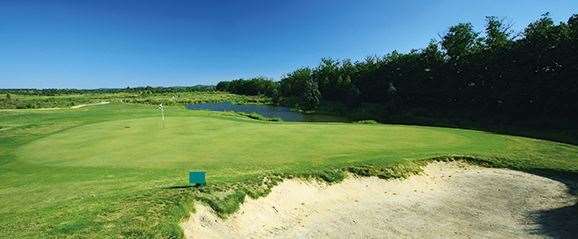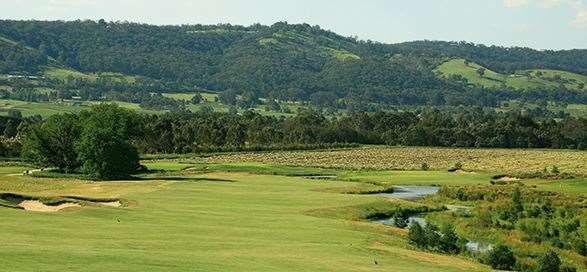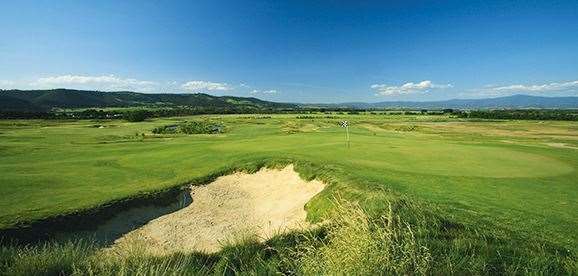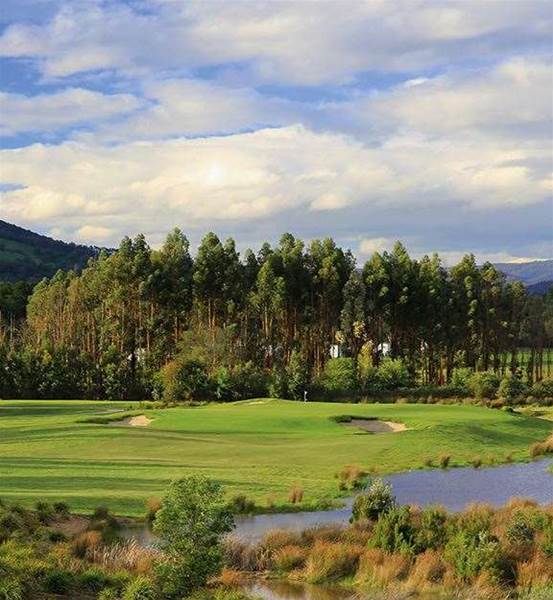More than six years after relocating from its former homer at Croydon Golf Club, Yering Meadows is now an integral part of the Yarra Valley golf scene.
More than six years after relocating from its former homer at Croydon Golf Club, Yering Meadows is now an integral part of the Yarra Valley golf scene.
WORDS: STEVE KEIPERT PHOTOGRAPHY: BRENDAN JAMES
Yering Meadows is in the paradoxically intriguing situation of being a young golf course with an old club driving it.
 The 24th hole, the 6th on the third nine at Yering Meadows, is one of several fine short par-4s.
The 24th hole, the 6th on the third nine at Yering Meadows, is one of several fine short par-4s.The former Croydon Golf Club became the first of now several established clubs to dip its toes in the waters of relocation when the suburban Melbourne club upped stumps last decade and moved to a new site in the Yarra Valley. As is happening with increasing regularity amid the urban squeeze, the land at Croydon was simply too valuable for the club to ignore the offer put forward by developers Australand. The club swapped 80 years of history at its original site to begin again 20-plus kilometres away at Yering, banking a significant sum of money and expanding to 27 holes in the process.
The land at Yering comprises 131 hectares – ample space for two courses, and that was the initial intention. Add a little government bureaucracy to the pot and stir, however, and you come up with a local council edict that states land used for outdoor reaction needs to allocate some space (in this case 16 hectares) to agriculture. The end result is 27 holes rather than 36 and a not insignificant walnut plantation spread across three groves and lining several fairways.
Prolific course architect Ross Watson won the commission to pen the layout and play began on the first 18 holes in June 2008 before the third nine opened the next year. The separate loops can be configured into three different 18-hole layouts: the Nursery, Homestead and Valley courses. The surfeit of space also allowed the design to incorporate excellent practice facilities that include a broad, full-length range and two practice greens, one of which can double as a 28th hole if required. Completing the picture is a sprawling and spacious modern clubhouse that sits atop a ridge on the high point of the property, affording panoramic views up the stunning Yarra Valley.
 The par-3 16th is a highlight of the 27-hole Yering Meadows layout.
The par-3 16th is a highlight of the 27-hole Yering Meadows layout.Six-and-a-half years after the move and the Yering Meadows course has matured in the manner you would expect given that timeframe and the Yarra Valley’s variable climate. Several refinements – both for cosmetic and playability and/or maintenance reasons – give the layout a settled look and feel. An example is the scenic 8th green where the front edge that borders a pond was reinforced last year with sleepers and a line of rocks. This change highlights the transition from the greenside hazard and draws golfers’ eyes to the danger. Elsewhere, the back tee at majestic par-3 16th was raised and moved slightly to the right about two years ago to improve visibility. The left quarter of the wide green was previously obscured by overhanging tree limbs and allowed little avenue for a left-to-right ball flight to find that part of the target.
The golf course looks like it was imposed upon the countryside without being an imposition. Fairways and waterways mingle seamlessly if relentlessly, as the aqua is a constant theme throughout. Several of Watson’s ponds and wetlands are crucial architectural features; others are there for decoration or irrigation. What you do notice, though, is how much water there is. These hazards are a factor on almost every hole on the Nursery course (holes 1 to 18) but often as a cursory adjunct to the layout of the fairway. Water is less prevalent across holes 19 to 27 but the lakes you see in this portion of the course are most definitely in play.
 The par-5 10th shows off the surrounding Yarra Valley scenery.
The par-5 10th shows off the surrounding Yarra Valley scenery.Many of Watson’s familiar design traits are on show at Yering Meadows. His bunker placement and ability to hide land between sets of bunkers are evident throughout. This magic act is most visible at the uphill par-5 27th, where the bunkers scattered along the last 130 metres to the green appear to be staggered one after the other yet as you walk nearer to them, the hidden pastures reveal themselves. Most bunkers are deep and act as a stiff penalty for drives finishing in sand.
The greens are large and many include raised or lowered levels where the clever contours can help or hinder rolling shots. Two greens – the 18th and 27th – feature ridges containing a slight point that can complicate putts moving up, down or along these slopes. Chances are you will face multiple long and complicated putts in the course of playing 18 holes but such long curlers are more demanding than they are diabolical.
 A green with two distinct levels characterises the par-3 25th hole.
A green with two distinct levels characterises the par-3 25th hole.The fairways are mostly generous and the club chooses to not make the rough too penal, however this means balls heading for the creeks and ponds are often not stopped by longer grass on their journey towards the drink. Watson mostly provides safe lines from the par-4 and par-5 tees but that option toughens the angle of the approach shot. Hugging the danger lines opens up these angles.
Holes 1 to 18, the Nursery course, send play immediately down to flatter land from elevated tees near the clubhouse. The first nine meanders across gently rolling terrain that reveals some of the Nursery layout’s best holes, beginning at the 4th. This 327-metre par-4 is driveable from the forward tees as a scheme of bunkers that dominates the fairway can propel balls near the green if carried with the drive. The 5th is a powerful par-5 running in the opposite direction with a dipping fairway and water left off the tee and bunkers on the right. A large central bunker must be challenged on the second shot before a green with drop-offs short and right. Likewise, the lengthy par-4 6th features a single bunker near the centre of the fairwaythen a creek short of the raised green. Bunkers right and a fall-away area left of the green toughen the approach shot, which favours a high, left-to-right shape.
 The uphill par-4 18th serves up few easy pars.
The uphill par-4 18th serves up few easy pars.A cute short par-3 at the 7th precedes arguably the best hole of the 27. The 497-metre par-5 8th snakes left around four fairway bunkers then trundles downhill towards a green framed by water short and right just a pace or two from the putting surface so never out of play until your ball is in the cup. It’s a harrowing approach shot, whether it’s for your second, third or fourth.
Like the opening nine, the middle nine begins quietly then grabs your attention from the fourth test, the start of an excellent pocket of holes.
The par-5 13th has water in play on the second and third shots and, like the par-5 10th before it, there’s a crossing before the green to guard the right side on the lay-up and left side of the green. The 14th is a solid short par-4 with water flanking the left side of the fairway and the better side from which to attack the green. The 15th is an even better short par-4 where those players opting not to attempt a risky water carry straight at the green will instead have to thread a tee shot between three strategically placed fairway bunkers. The best play is actually to stay short of all the sand to open the best angle to the long green.
The par-3 16th is the pick of Yering’s short holes. It plays across water that wraps around the left side of a wide green. The putting surface contains a dastardly far-left hole location that adds to the degree of difficulty, while there is room to bail out short and right of the green. This nine closes with a tough uphill par-4 that climbs most sharply for the second shot. The green is framed by two imposing bunkers in front and a slope on the right side that sends balls hitting that side into a chipping area below the level of the two-tiered green.
Holes 19 to 21, a trio of up-and-back par-4s, are about as ho-hum as things get, before the third nine ramps up significantly. It arguably offers more contrast to the other two nines and so mixing it with either of the 1-9 or 10-18 loops provides the best snapshot of Yering Meadows – assuming, of course, that you don’t have time to play all 27.
There’s an excellent medley of holes beginning at the 130-metre 22nd. Watson is a master of designing short but brilliant par-3s and this innocuous one-shotter adds to that reputation. Requiring little more than a wedge or 9-iron, the uphill shot must be judged to perfection whether the flag is on the raised rear shelf of the green or the lower front section as sand swallows any shots coming up short. The 23rd is a reachable par-5 moving downhill and sloping towards water on the left that’s in play after the tee shot. Second shots positioned as close to the lake as possible create the ideal angle to most flag positions.
The toughest hole on the property falls at the 26th. This long, 418-metre par-4 is lined by water up the entire left side with more wetlands partially in play opposite. Second shots, likely struck from 180 metres or more, need to carry or skip over a creek in front of the deep green. Whichever way you tackle the three nines, this hole is the No.1 index and is best played as such, which means taking three or more swings to find the green.
 The toughest hole of the lot is the long par-4 26th hole.
The toughest hole of the lot is the long par-4 26th hole.THE COURSE
LOCATION: Victoria Rd, Yering. About 55 minutes’ drive east of the Melbourne CBD via the Eastern Freeway and Maroondah Highway. The drive from the Sandbelt region takes about 50 minutes.
CONTACT: (03) 9738 9000.
WEBSITE: www.yeringmeadows.com.au
DESIGNER: Ross Watson (2008).
SLOPE RATINGS: Nursery: men: 144/136/131; women: 135/131/123; Homestead: men: 142/139/130; women: 134/130/120; Valley: men: 144/134/127; women: 134/133/123.
PLAYING SURFACES: Santa Ana couch (tees), Legends couch (fairways), Hard, Sheeps and Red fescues (rough), Creeping Bentgrass (greens).
COURSE SUPERINTENDENT: Toby Drummond.
PGA PROFESSIONALS: Geoff George, Michael Waghorn.
GREEN FEES: $55 (weekdays); $65 (weekends).
THE CLUB
MEMBERSHIPS: Categories include two-, five-, six- and seven-day (male and female), limited access (20 rounds), intermediate, junior, social, daylight savings (spanning October to March) as well as trial memberships in various categories. The club is waiving the joining fee on memberships for the rest of 2014.
RECIPROCAL CLUBS: Cohuna, Maffra, Murray Downs, Shepparton, Swan Hill (Victoria); Coolangatta-Tweed Heads, Lithgow, Merewether, Queanbeyan, Roseville, Yarrawonga (New South Wales); Gold Coast, Nudgee, Redland Bay, Virginia (Queensland); Mt Lofty, Port Lincoln, The Vines of Reynella (South Australia); Ulverstone (Tasmania); Melville Glades, Royal Fremantle, Sea View (Western Australia); Alice Springs (Northern Territory); The Hutt, Remuera, Waiuku (New Zealand); and Morton Hall (Scotland).
CORPORATE GOLF: Yering Meadows is fully equipped to manage corporate golf events. Inclusions range from clinics to catering. The preferred days are Monday, Thursday and Friday.
FACILITIES: The Grove Restaurant is open on Friday evenings from 5.30pm and for Sunday lunch from 12.30pm to 3pm. High Tea is served from 3pm to 5.30pm on Saturdays and Sundays. The club also caters for functions and conferencing for as few as six people in the Hamilton White Room to as many as 350 people in the Vista Room.
Related Articles

Review: Omaha Beach Golf Club

Drinks With... Ricky Ponting













